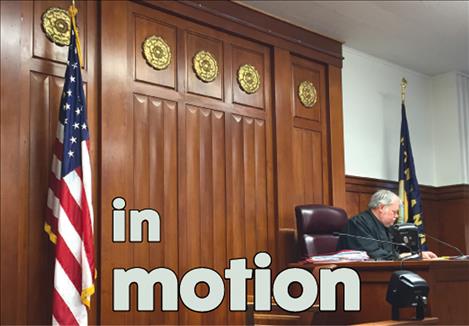Judge seeks to implement drug court by summer
Hey savvy news reader! Thanks for choosing local.
You are now reading
1 of 3 free articles.
Lake County District Court Judge James A. Manley is trying to make a difference in the lives of drug users and the community at large.
A $360,000 grant from the U.S. Justice Department is expected to come in the spring and could be implemented by summer, he said. Manley wants to use those funds to set up a drug court and run it based on one in Billings that’s been in operation about 15 years.
Manley didn’t realize how bad the drug problem was in Lake County when he was appointed a little more than three years ago to fill the seat of longtime former Judge C.B. McNeil.
“I knew nothing about the meth epidemic in our community,” Manley said. “It’s exploded since then.”
In 2012, there were 182 felony cases filed in Lake County. For 2016, there were 458 filed through Dec. 19, an increase of more than 250 percent. Of those, at least 90 percent are drug-related, Manley said, and 80 to 90 percent methamphetamines.
Drug-related crimes can involve possession or sales of drugs, property crimes to pay for one’s habit and other crimes committed as a result of drug use.
Possibly the worst part about the drug epidemic is what it leaves in its wake.
“The number of children born to addicted parents has exploded,” said Manley, noting that St. Joseph’s Hospital has identified that as the No. 1 community problem.
Almost all of the drug addicts that he sees in court are parents.
Manley said he had to go on a “crash course” when he became district court judge. This involved reading medical and scientific research.
“The more I learned, the more troubled I became,” he said.
The local recidivism rate for drug offenders is at least 75 percent, he said. That means they are arrested and charged with a new crime within two years.
The costs for dealing with drugs are astronomical, he said. “It costs $35,000 to $40,000 to incarcerate a person for one year,” he said.
Using what he calls a conservative estimate, Manley believes it costs around $100,000 per case when someone is charged with a felony. These costs are spread across several agencies, including the sheriff’s office, jail, district court, prosecutors, defense attorneys, probation and parole, prisons and drug treatment programs.
For 500 felonies, that’s $50 million, which represents more than the county or school district budgets combined, Manley said. (The county’s budget is $22.7 million and Polson Schools’ is $17.4 million.)
“We’ve reached critical mass,” he said. The Lake County Jail, which has a capacity of 46 inmates, usually houses between 50 and 60 people, according to Undersheriff Ben Woods. “We have 1,600 to 1,800 active warrants that we can’t serve because of lack of space,” he said. “We arrest very few warrants. It’s the baddest of the bad, the worst of the worst.”
Sheriff Don Bell said he has been talking to the county commissioners about building a new jail since he was elected in November 2014. The current jail was built in 1923, and the latest remodel, which added a recreation room as a result of a lawsuit by the American Civil Liberties Union, came in 1996. Bell said the county commissioners earlier this year requested a needs assessment be done in regard to the jail. He said a new jail should have a capacity of 175-220.
“The jail is full all of the time,” Manley said. “They have to release serious felony cases sometimes to make room for a more serious felony case.” And those who have been sentenced to the Department of Corrections have to wait in jail for weeks or months until DOC has room for them, he said.
With that in mind, Manley’s former law clerk Matt McKeon and chief deputy county attorney James Lapotka attended drug courts in Billings, Butte, Great Falls and Missoula to look at other options.
“They have figured out a better way,” Manley said, adding that he used to think “you punish people and they won’t do it.” However, “you can’t punish it out of them. You can’t do that anymore than you can punish mental illness out of someone.”
The Billings drug court, which is the oldest in the state, has a recidivism rate of about 17 percent, he said.
Using the Billings’ model, Manley and others would make up a team to screen drug addicts for enrollment in the drug court. Others who have agreed to be on the team include: Lapotka, adult probation officer Katie Campbell, Confederated Salish Kootenai Tribes councilwoman Carole Lankford, defense attorneys Britt Cotter and Robert Long, Undersheriff Woods, addiction specialist Jay Brewer and Christina Ellsworth of Community Supervision Alternatives in Missoula.
The program would have two facets: accountability and treatment/rehabilitation. Participants would be drug-tested at least twice a week and would have to complete inpatient or outpatient treatment and rehab. They would also get education and job training and could receive mental health counseling.
The broad-based program would take about two years to complete. To graduate, one must be clean and sober for six months and be self-supporting, Manley said.
The Lake County Drug Court Team would meet weekly at district court. The drug court can’t be started too soon because black tar heroin is making its way into the area, Manley said.
Another facet of illegal drug use is synthetic drugs, which even though some concoctions have been outlawed, new formulas are being made that closely resemble the chemical makeup of known drugs.
In addition to that, Adderall, which can be prescribed for hyperactivity disorder, is one molecule different than meth but its effect isn’t any different, Manley said.
Desoxyn, which is sometimes prescribed for weight loss, is also no different chemically than meth, he said. “Over 90 percent of people who are prescribed these drugs don’t get addicted,” he said. “Why are those we see getting addicted and others aren’t?”
Contrary to popular belief, “the great majority don’t get addicted after one use, or ever,” he said, citing a “rat park” experiment as evidence.
“People can turn it down and quit using,” he said. “Historically, very few addicts are over 40. Some die, but a significant number get tired of it and outgrow it … If they can turn it down, why don’t they? The answers are complex … Some may have lost hope, don’t care and are very damaged mentally and emotionally.”
Some of the books that Manley has read recently about the drug epidemic include: “Dreamland: The True Tale of America’s Opiate Epidemic,” by former LA Times reporter Sam Quinones; “Chasing the Scream: The First and Last Days of the War on Drugs,” whose author, Johann Hari, is a British journalist; and “High Price,” written by Columbia University neuroscientist, Dr. Carl Hart.
Manley said it’s not only tiring but also disillusioning to see the same drug-related offenders in court, over and over. “It’s kind of consumed my job in a way,” he said. “It’s the bulk of what I do.”



















